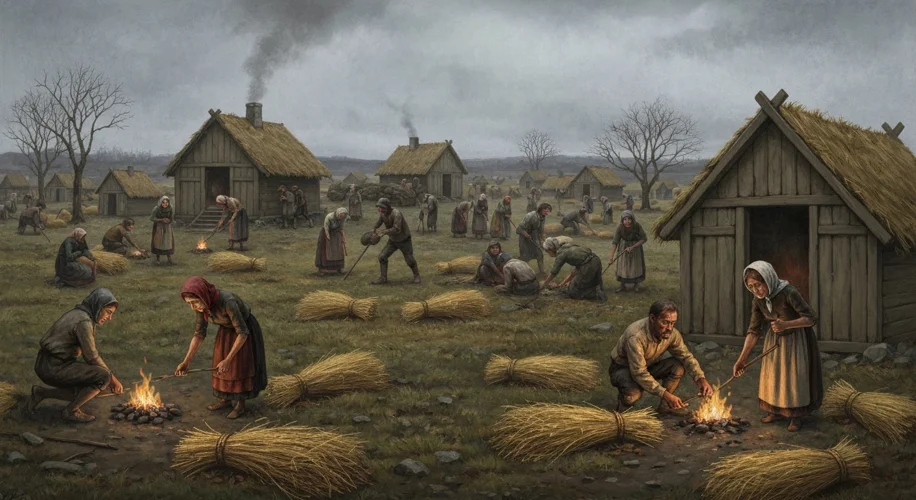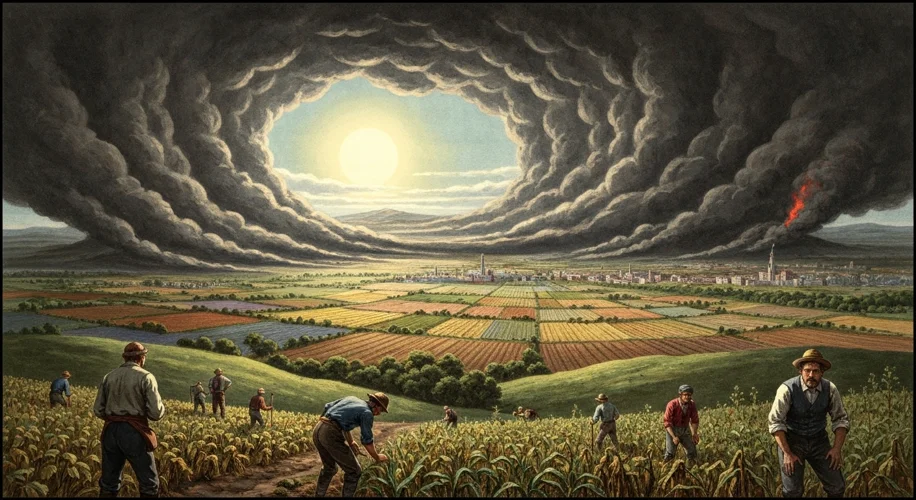Let us envision: a world plunged into an unnatural twilight, harvests failing, and a gnawing hunger spreading like a chilling frost across continents. This wasn’t a scene from a dystopian novel; it was the grim reality that followed the cataclysmic eruption of Mount Tambora in 1815, an event that unleashed not only geological fury but also a global climate catastrophe, forever etching 1816 into history as the ‘Year Without a Summer’.
A Rumble from the Deep
On April 10, 1815, on the island of Sumbawa in present-day Indonesia, Mount Tambora, a colossal stratovolcano, awakened from its slumber with a violence that defied imagination. For days, the sky above the Indian Ocean turned black, not from nightfall, but from the sheer volume of ash and debris hurled miles into the atmosphere. The sound of the eruption was heard over 1,600 miles away, a deafening roar that signaled the beginning of a global upheaval. Tambora, once a majestic peak, was literally blown apart, its summit collapsing inwards to form a caldera nearly seven miles wide and a mile deep. The eruption was classified as a VEI 7, the second-largest volcanic event in recorded human history, dwarfing even the infamous Krakatoa eruption centuries later.

The immediate vicinity of Tambora was a scene of unimaginable devastation. Pyroclastic flows, superheated avalanches of gas and volcanic matter, incinerated everything in their path. Tsunamis, generated by the volcanic collapse and subsequent underwater explosions, ravaged the coastlines of surrounding islands, sweeping away villages and their inhabitants. Thousands perished in the initial onslaught, but the true impact of Tambora was yet to unfold, a slow-motion disaster rippling across the globe.
The World Holds its Breath
The sheer quantity of volcanic gases, particularly sulfur dioxide, injected into the stratosphere by Tambora’s eruption acted like a planetary-sized sunscreen. This sulfur reacted with water vapor to form a veil of sulfuric acid aerosols, a persistent layer that circled the Earth, reflecting sunlight back into space. The consequences were immediate and devastating for the Northern Hemisphere. The year 1816 dawned with a chilling abnormality: a profound and pervasive lack of summer warmth.
In North America, New England experienced frost and snow in June and July. Crops like corn, wheat, and oats, vital staples for the burgeoning populations, withered under the unseasonable cold and persistent rain. Farmers watched in despair as their fields turned to mud, their livelihoods vanishing with each passing bleak day.
Across the Atlantic, Europe fared no better. Great Britain endured a relentlessly wet and cold summer. Rivers overflowed their banks, and coastal regions were battered by storms. Food prices soared as grain harvests failed. In Switzerland, starvation became rampant, forcing people to consume moss, roots, and even to resort to cannibalism in some extreme accounts. The social fabric strained under the immense pressure of widespread hunger and desperation.
A Symphony of Suffering
Little did the ordinary folk, tending to their failing crops or huddling against the perpetual chill, realize the connection to a distant Indonesian volcano. Their world was reduced to a desperate struggle for survival. Families faced starvation, disease outbreaks like typhus and cholera, exacerbated by malnutrition and poor sanitation, swept through communities. The economic repercussions were severe, leading to riots and increased social unrest as people protested the rising cost of food and the perceived indifference of authorities.

Amidst this widespread misery, creative sparks also flickered. In 1816, a young Mary Shelley, along with Lord Byron, Percy Bysshe Shelley, and John Polidori, were staying at Villa Diodati on the shores of Lake Geneva. Trapped indoors by the incessant rain and gloom, they engaged in ghost story writing competitions. It was during this atmospheric and unsettling summer that Mary Shelley conceived the idea for her seminal work, Frankenstein; or, The Modern Prometheus, a tale reflecting the anxieties of a world grappling with unnatural forces and the potential for human ambition to unleash unintended consequences.
The Long Shadow of Tambora
The eruption of Mount Tambora and the ensuing Year Without a Summer serve as a stark reminder of humanity’s vulnerability to the immense power of nature. The event triggered not only immediate agricultural collapse and famine but also had longer-term consequences. It contributed to migration patterns, with many displaced individuals seeking new opportunities elsewhere, impacting settlement in regions like the American Midwest.
Tambora’s climatic effects also influenced the infamous “Donner Party” – the ill-fated group of American pioneers who, on their journey to California in 1846, resorted to cannibalism after being trapped by early winter snows in the Sierra Nevada mountains. While the direct causal link is debated, the environmental instability and hardships experienced in the decades following Tambora may have played a subtle role in shaping the arduous conditions faced by westward migrants.
Beyond its immediate human toll, the eruption of Tambora left an indelible mark on the scientific understanding of volcanism and climate. Scientists began to correlate volcanic activity with atmospheric changes, laying groundwork for future studies in climate science. The catastrophic disruption of global weather patterns highlighted the interconnectedness of Earth’s systems and the profound impact that a single, massive volcanic event could have on a planetary scale. The aerosols injected into the stratosphere, while causing widespread cooling, also produced spectacular sunsets and vibrant atmospheric phenomena observed across the globe, as artists and naturalists documented these unusually vivid displays.
In conclusion, Mount Tambora’s eruption was far more than a regional disaster. It was a global climate-altering event that reshaped landscapes, economies, and societies. The Year Without a Summer stands as a testament to the raw power of our planet, a somber chapter in human history that underscores the fragility of our existence and the profound impact that natural forces can have on the course of civilization. The echoes of Tambora’s fury continue to resonate, reminding us of the delicate balance of our climate and the ever-present potential for nature’s dramatic interventions.

